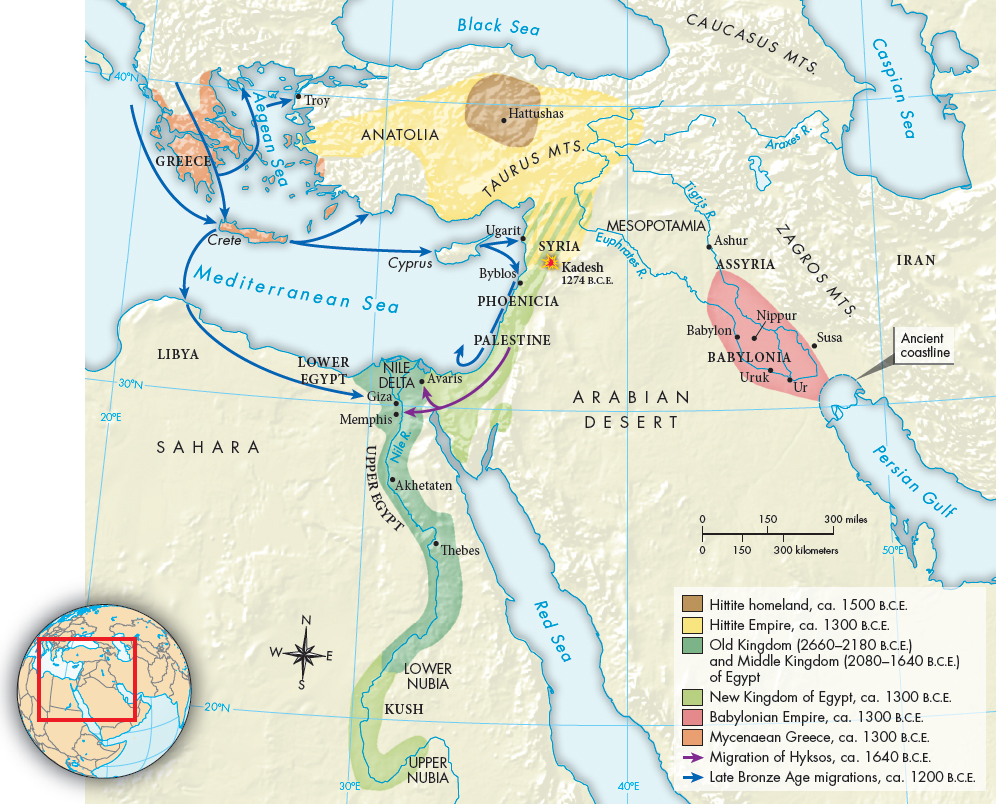The Hyksos and New Kingdom Revival
While Egyptian civilization flourished in the Nile Valley, various groups migrated throughout the Fertile Crescent and then accommodated themselves to local cultures (Map 1.2). Some settled in the Nile Delta, including a group the Egyptians called Hyksos, which means “rulers of the uplands.” Although they were later portrayed as a conquering horde, the Hyksos were actually migrants looking for good land, and their entry into the delta, which began around 1800 B.C.E., was probably gradual and generally peaceful.

MAP 1.2 Empires and Migrations in the Eastern MediterraneanThe rise and fall of empires in the eastern Mediterranean were shaped by internal developments, military conflicts, and the migration of peoples to new areas.> MAPPING THE PASTANALYZING THE MAP: At what point was the Egyptian empire at its largest? The Hittite empire? What were the other major powers in the eastern Mediterranean at this point?
CONNECTIONS: What were the major effects of the migrations of the Hyksos? Of the late Bronze Age migrations? What clues does the map provide about why the late Bronze Age migrations had a more powerful impact than those of the Hyksos?
The Hyksos brought with them the methods of making bronze and casting it into tools and weapons that became standard in Egypt. The Hyksos also brought inventions that revolutionized Egyptian warfare, including bronze armor and weapons as well as horse-drawn chariots and the composite bow, made of laminated wood and horn, which was far more powerful than the simple wooden bow.
The migration of the Hyksos, combined with a series of famines and internal struggles for power, led Egypt to fragment politically in what later came to be known as the Second Intermediate Period (1640–1570 B.C.E.). During this time, the Egyptians adopted bronze technology and new forms of weaponry from the Hyksos, while the newcomers began to worship Egyptian deities and modeled their political structure on that of the Egyptians.
In about 1570 B.C.E., a new dynasty of pharaohs arose, pushing the Hyksos out of the delta, subduing Nubia in the south, and conquering parts of Canaan in the northeast. In this way, these Egyptian warrior-pharaohs inaugurated what scholars refer to as the New Kingdom — a period in Egyptian history characterized by not only enormous wealth and conscious imperialism but also a greater sense of insecurity because of new contacts and military engagements. By expanding Egyptian power beyond the Nile Valley, the pharaohs created the first Egyptian empire.
The New Kingdom pharaohs include a number of remarkable figures. Among these was Hatshepsut (r. ca. 1479–ca. 1458 B.C.E.), one of the few female pharaohs in Egypt’s long history, who seized the throne for herself and used her reign to promote building and trade. Amenhotep III (r. ca. 1388–ca.1350 B.C.E.) corresponded with other powerful kings in Babylonia and other kingdoms in the Fertile Crescent, sending envoys, exchanging gifts, and in some cases marrying their daughters. The kings promised friendship and active cooperation. They made alliances for offensive and defensive protection and swore to uphold one another’s authority. Hence, the greatest powers of the period maintained peace, which facilitated the movement of gifts between kings and trade between ordinary people.
Amenhotep III was succeeded by his son, who took the name Akhenaten (ah-keh-NAH-tuhn) (r. 1351–1334 B.C.E.). He renamed himself as a mark of his changing religious ideas. Egyptians had long worshipped various sun-gods and aspects of the sun — Ra, Amon, Amon-Ra — but Akhenaten favored instead the worship of the god Aten (also spelled Aton), the visible disk of the sun. He was not a monotheist (someone who worships only one god), but he did order the erasure of the names of other sun-gods from the walls of buildings, the transfer of taxes from the traditional priesthood of Amon-Ra, and the building of huge new temples to Aten, especially at his new capital in the area now known as Amarna. In these temples Aten was to be worshipped in bright sunlight. Akhenaten also had artists portray him in more realistic ways than they had portrayed earlier pharaohs; he is depicted interacting with his children and especially with his wife Nefertiti (nehf-uhr-TEE-tee), who supported his new religious ideas. (See “Individuals in Society: Hatshepsut and Nefertiti.")
Akhenaten’s new religion, imposed from above, failed to find a place among the people, however. After his death, traditional religious practices returned and the capital was moved back to Thebes. The priests of Amon-Ra led this restoration, but it was also supported by Akhenaten’s son. This son was Tutankhamon (r. 1333–1323 B.C.E.), whose short reign was not particularly noteworthy and whose name would probably not be remembered except for the fact that his was the only tomb of an Egyptian king to be discovered nearly intact.
Tutankhamon’s short reign was also marked by international problems, including warfare on several of the borders of the Egyptian empire. His grandfather and father had engaged in extensive diplomatic relations with rulers of states dependent on Egypt and with other powerful kings, but Tutankhamon was less successful at these diplomatic tasks. He also died childless. His successors were court officials, and in 1298 B.C.E. one of them established a new dynasty whose members would reassert Egypt’s imperial power and respond to new challenges.
